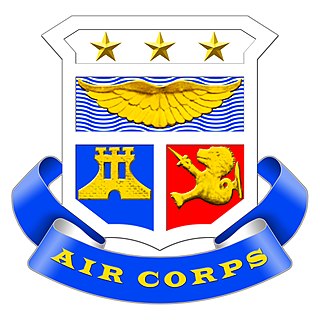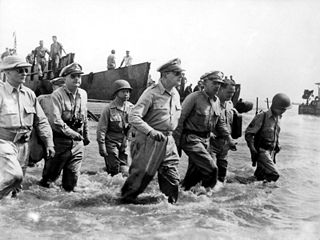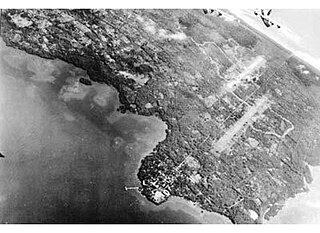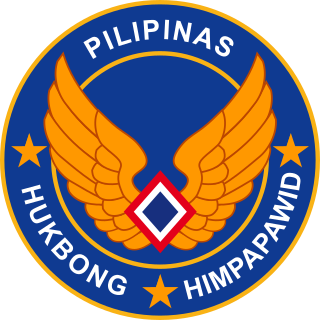
The Philippine Army Air Corps was created in 1935 as the air component of the Philippine Army. It was the predecessor of the Philippine Air Force, created in 1947.

Palawan, officially the Province of Palawan, is an archipelagic province of the Philippines that is located in the region of Mimaropa. It is the largest province in the country in terms of total area of 14,649.73 km2 (5,656.29 sq mi). The capital and largest city is Puerto Princesa wherein it is geographically grouped but administered independently from the province. Palawan is known as the Philippines' Last Frontier and as the Philippines' Best Island.

Colonel Jesus Villamor Air Base, known simply as Villamor Air Base, is the headquarters of the Philippine Air Force (PAF) and shares runways with Ninoy Aquino International Airport (NAIA). It was formerly known as Nichols Field or Nichols Air Base. Chiefly used as a PAF transport/helicopter airbase, the Maharlika Hall located at the base is used by the president of the Philippines when departing for foreign or domestic trips. Also, foreign dignitaries visiting Manila would usually arrive at the air base.

Puerto Princesa, officially the City of Puerto Princesa, is a 1st class highly urbanized city in the Mimaropa region of the Philippines. According to the 2020 census, it has a population of 307,079 people.
The Commonwealth of the Philippines was attacked by the Empire of Japan on 8 December 1941, nine hours after the attack on Pearl Harbor. Although it was governed by a semi-independent commonwealth government, the United States of America controlled the Philippines at the time and possessed important military bases there. The combined Filipino-American army was defeated in the Battle of Bataan, which saw many war crimes commited and the Battle of Corregidor in April 1942, but guerrilla resistance against the Japanese continued throughout the war. Uncaptured Filipino army units, a communist insurgency, and supporting American agents all played a role in the resistance. Due to the huge number of islands, the Japanese never occupied many of the smaller and more minor islands. The Japanese control over the countryside and smaller towns were often tenuous at best.
Palawan Broadcasting Corporation (PBC) is a Philippine media network. Its corporate office is located in Puerto Princesa.

The Philippines campaign, Battle of the Philippines, Second Philippines campaign, or the Liberation of the Philippines, codenamed Operation Musketeer I, II, and III, was the American, Mexican, Australian and Filipino campaign to defeat and expel the Imperial Japanese forces occupying the Philippines during World War II.

The Invasion of Palawan, was fought by U.S. liberation forces against the Japanese from 28 February to 22 April 1945, in a series of actions officially designated as Operations Victor I and II, and part of the campaign for the liberation of the Philippines during World War II, was waged to initiate the recapture of the southern islands of the Philippine archipelago, end the Japanese occupation, and secure them from remaining Japanese forces.

Puerto Princesa International Airport is an airport serving the general area of Puerto Princesa, located in the province of Palawan in the Philippines. It is classified as an international airport by the Civil Aviation Authority of the Philippines.

Mactan–Benito Ebuen Air Base, originally known as Mactan Air Base, is an active military airbase of the Philippine Air Force (PAF). It is located on the island of Mactan, Cebu, in the Visayas region of the Philippines. It shares its single runway with the civilian Mactan–Cebu International Airport. Mactan Air Base was originally built by, and was a facility of the United States Air Force (USAF), until the American military units left the country in 1991, whereby full and total control was handed over to the Philippine Air Force.

Antonio Marfori Bautista was an F-86 Sabre pilot who served in the Philippine Air Force. He served in the aerobatic display team the Blue Diamonds and fought against rebels in the south of the country. He was killed in action in January 1974.

Cesar Basa Air Base, or simply Basa Air Base, is an airbase currently operated by the Philippine Air Force. It is located at Floridablanca, Pampanga about 40 miles (64 km) northwest of Metro Manila in the Philippines. It is named after César Basa, one of the pioneer fighter pilots of the Philippine Air Force.

The PAF Blue Diamonds is the national aerobatic team of the Philippine Air Force (PAF). Assigned to the 5th Fighter Wing, the unit is based at Basa Air Base in Floridablanca, Pampanga. Founded in 1952, the Blue Diamonds is one of oldest formal flying aerobatic teams in the world, along with United States Air Force Thunderbirds founded in 1953, the United States Navy Blue Angels formed in 1946, and the Patrouille de France of the French Air Force formed in 1931. The Blue Diamonds has been inactive since 2005.

The Air Force Reserve Command, known officially as the AIR RESCOM or RESCOM, is one of the Philippine Air Force's Major Support Commands created for the sole purpose of Reserve Force management, procurement, and organization.

The Philippine Air Force (PAF) is the aerial warfare service branch of the Armed Forces of the Philippines. Initially formed as part of the Philippine Army as the Philippine Army Air Corps (PAAC) in 1935, the PAAC eventually saw combat during World War 2 and was formally separated from the Army in 1947 as a separate service branch of the AFP under Executive Order No. 94. At present, the PAF is responsible for both defending the Philippine airspace, and conducting aerial operations throughout the Philippines, such as close air support operations, combat air patrols, aerial reconnaissance missions, airlift operations, helicopter tactical operations, special operations, and aerial humanitarian operations, which includes search and rescue operations. The PAF has also carried out various missions within the country and abroad.

The Palawan massacre occurred on 14 December 1944, during World War II, near the city of Puerto Princesa in the Philippine province of Palawan. Allied soldiers, imprisoned near the city, were killed by Imperial Japanese soldiers. Only eleven men managed to survive.
Edwin Andrews Air Base is located in Zamboanga, Philippines. The base operates through Runway 09/27, which has a length of 2,611 m (8,566 ft), along with the Zamboanga International Airport and conducts air operations against insurgents like the Moro Islamic Liberation Front.

Naval Base Puerto Princesa, Naval Base Palawan, was a United States Navy base built during World War II at Puerto Princesa on Palawan Island, Philippines, after the Invasion of Palawan on February 28, 1945. Puerto Princesa Bay offered an excellent base for fleet anchorage. At the naval base, US Navy Seabees built: a seaplane base, carrier aircraft fighter plane repair depot, land airfield and other base facilities.

US Naval Base Philippines was number of United States Navy bases in the Philippines Islands in the Pacific Ocean. Most were built by the US Navy Seabees, Naval Construction Battalions, during World War II. The US Naval Bases in Philippines were lost to the Empire of Japan in December 1941 during the Philippines campaign of 1941–1942. In February 1945 the United States Armed Forces retook the Philippines in the Battle of Manila in 1945. Before the captured US bases on Luzon were retaken the US Navy Seabees built a new large base, Leyte-Samar Naval Base, on the Philippine Island of Leyte, starting in October 1944.

















